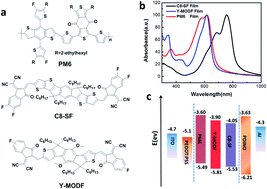Enhanced performance of ternary organic solar cells with a wide bandgap acceptor as the third component†
Abstract
Two n-type organic semiconductor (n-OS) acceptors, C8-SF and Y-MODF, were designed and synthesized for application in organic solar cells (OSCs). C8-SF shows a lower lowest unoccupied molecular orbital (LUMO) energy level and lower bandgap with an absorption edge at 822 nm. Y-MODF possesses a relatively larger bandgap and higher LUMO and lower HOMO (highest occupied molecular orbital) energy levels than C8-SF. With the polymer PM6 as the donor, the OSC with C8-SF as the acceptor delivers a power conversion efficiency (PCE) of 11.59% with a lower open circuit voltage (Voc) of 0.787 V, while the device with Y-MODF as the acceptor exhibits a lower PCE of 8.63% but a higher Voc of 0.984 V benefitting from the higher LUMO of the Y-MODF acceptor. Then, a series of ternary OSCs were fabricated with PM6:C8-SF as the host system and Y-MODF as a third component. The optimal ternary OSCs with 25% Y-MODF incorporated into the acceptor achieve a higher PCE of 13.39%, with an improved Voc of 0.845 V, a Jsc of 20.88 mA cm−2 and a FF of 75.87%. It was found that adding Y-MODF to the PM6:C8-SF binary system suppressed monomolecular recombination and improved the utilization of 450–600 nm range photons. Molecular packing is further optimized with more balanced hole and electron transport, thus resulting in the enhanced Jsc and FF for the ternary OSCs. These results indicate that the addition of a wide bandgap acceptor with a higher LUMO energy level to a binary donor/acceptor system may have potential for Voc and PCE improvement of ternary OSCs.



 Please wait while we load your content...
Please wait while we load your content...